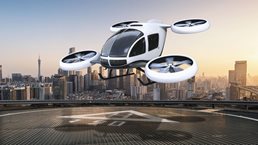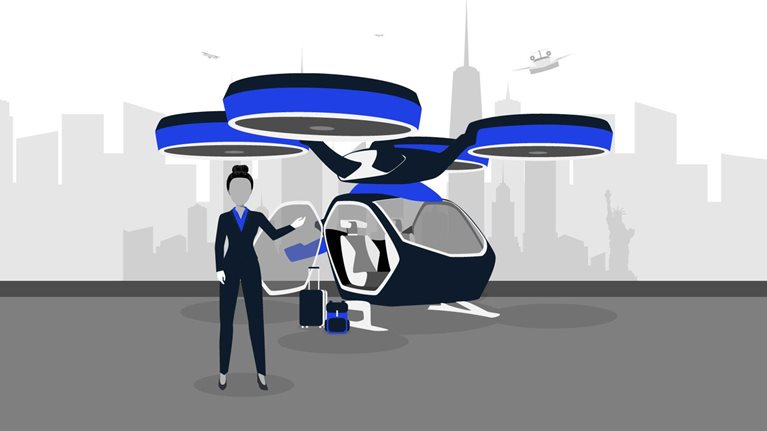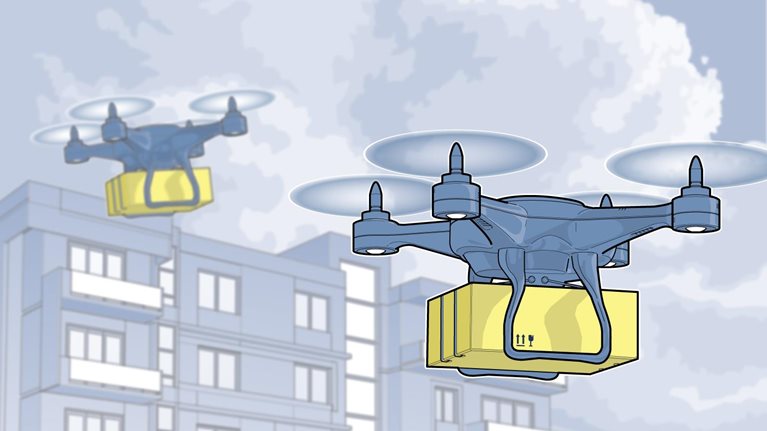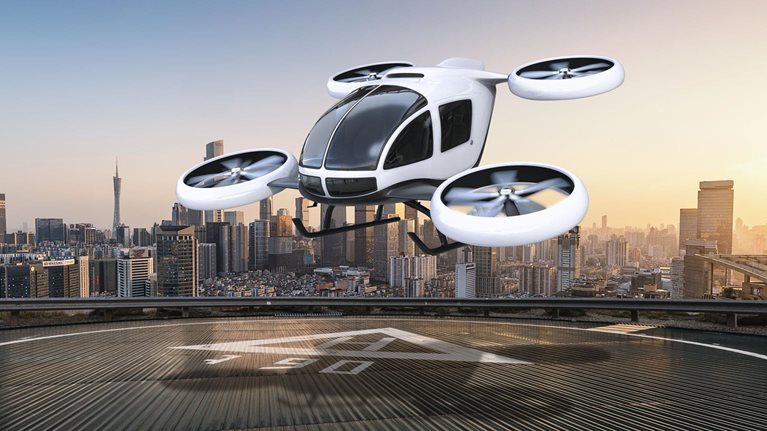Will it fly? Companies and investors in the fledgling advanced air mobility (AAM) industry are betting billions that the answer is yes. AAM features a new set of mobility use cases that include people and cargo transport—think flying taxis, cargo drones, and the like—and funding has accelerated in recent months. The uptick has been so rapid, in fact, that total disclosed investments exceeded $8 billion at the end of March 2021. People transport has seen the most recent investor interest, drawing more than 80 percent of total funding, but cargo-delivery drones might soon see an upsurge.
While investors and other industry stakeholders are excited about AAM’s potential, the consumer view is less clear. Will people happily board flying taxis and accept drone deliveries, or do some reservations remain? To gain a fuller understanding of the issues at play, as well as potential demand, McKinsey surveyed approximately 4,800 consumers in Brazil, China, Germany, India, Poland, and the United States in March 2021. The research involved use cases for both people moving and cargo transport. Our goal was to investigate consumers’ future willingness to adopt and pay for AAM services, as well as their preferences and concerns.
Asking people about a product or service that does not yet exist—including passenger AAM vehicles—is always challenging. After all, a consumer’s stated preference and actual behavior can differ, especially when the scenario involves a theoretical offering that is not yet on the market. That said, our survey does provide some important insights about potential use cases and the AAM market that industry stakeholders may find helpful as they plan their future strategies.
Consumer insights on flying taxis
We looked at six people-moving use cases involving widely different activities:
- commuting to and from work
- errands
- business travel
- short-distance leisure travel, such as trips to the cinema
- long-distance leisure travel, such as visits to family members in other cities
- trips to and from the airport as part of a longer journey
These potential use cases would involve AAM vehicles, such as electrical vertical takeoff and landing aircraft, electric conventional takeoff and landing aircraft, and electric short takeoff and landing aircraft, which fly at lower altitudes within urban, suburban, and regional areas. The AAM vehicles would be operated by pilots in the medium term, with semiautonomous or autonomous vehicles becoming available over the longer term.
Willingness to adopt passenger AAM and preferred use cases vary by country
Interest in using passenger AAM was highest in India and Brazil. From 31 to 47 percent of Indian respondents said they would definitely consider using an AAM vehicle in the future, depending on use case, as did 21 to 32 percent of Brazilian consumers (Exhibit 1). German respondents expressed the lowest interest level for most use cases, with the percent of respondents stating that they would use an AAM vehicle ranging from a low of 8 percent for long-distance leisure travel to a high of 17 percent for airport trips.

So far, no clear winning use case for people moving has emerged; in each country, most use cases attracted somewhat similar levels of interest. Still, there are indications of potential winners in each country. For instance, compared with respondents in other countries, US consumers had much higher interest in business travel. When we did a qualitative analysis of the survey comments, we discovered that a major reason for this sentiment was the perceived higher convenience of AAM vehicles. German consumers were much more likely to express willingness to adopt AAM services for airport trips than other use cases, and Polish consumers were less interested in adopting these services for short-distance leisure trips, selecting this use case one-third to half as often as the others.
Would you like to learn more about our Aerospace & Defense Practice?
Consumers had different motivations for considering manned services
When respondents were asked about their main reasons for considering manned AAM services, the largest share—more than 30 percent in each country—expressed a desire for shorter travel times (Exhibit 2). This preference was particularly evident in countries that rank high for congestion levels and time lost in traffic. For instance, 47 percent of Brazilian respondents and 41 percent of Indian respondents wanted shorter travel times. Unsurprisingly, four Indian cities and were among the world’s ten most congested in 2019, prior to the pandemic, and two of the twenty most congested cities were in Brazil.1 Across countries, the desire to have a more certain arrival time was also frequently cited as a reason to use an AAM vehicle.

India and Brazil show the most willingness to pay for future flying-taxi offerings
Some regional differences were observed in willingness to pay. Thirty-six percent of Indian consumers said they would definitely pay five times the price of their current transport mode to hop on an AAM vehicle for a trip to or from an airport, as did 30 percent of Brazilian respondents—the highest rates reported in our survey (Exhibit 3). These findings are likely related to the lower price levels for other mobility options in these countries, as well as the higher congestion rates and time lost to traffic. In the other countries, less than 20 percent of respondents were willing to pay the same premium for airport trips in an AAM vehicle.

Germany ranked lowest in willingness to pay, which might seem counterintuitive, since it has one of the highest disposable-income levels. When we analyzed the qualitative data and survey comments, however, we found that Germany’s excellent existing transportation infrastructure reduced the advantages of using an AAM vehicle for airport trips.
Our survey suggests that consumers are willing to pay a premium for AAM service even for traveling very short distances.

To take off, flying vehicles first need places to land
Today’s limousine and ride-hailing users might be first adopters
Almost 35 percent of today’s ride-hailing users for airport trips said they would definitely switch to an AAM vehicle, as did 32 percent of limousine users. These groups may be among the first adopters of AAM for two reasons: ride-hailing users are already accustomed to new shared-mobility options, and limousines are relatively expensive, making the higher price of an AAM vehicle less of a jump. Among taxi users, 29 percent say they would switch to an AAM vehicle, as would 27 percent of those who use car rentals. The cost of these services is comparable to those of limousines and ride hailing, so the price increase is again less of a factor. Those who used private cars or public transit for their trips were least likely to say they would switch (23 percent for each category). A possible explanation for public-transit users’ lower likelihood of switching is that this group may be the most price-sensitive.
The main consumer concerns about passenger AAM relate to safety and price
Across countries, over 60 percent of respondents said safety was their top concern about AAM vehicles, making it the most important issue by far. Many people appeared particularly concerned about autonomous flight—a development expected down the road. Our qualitative analysis of survey comments showed that some consumers have concerns about flying in piloted small aircraft today, making their hesitancy about autonomous flight unsurprising. Others indicated that autonomous travel should first demonstrate proof of concept on the ground.
About 10 to 20 percent of respondents across countries reported concerns about ticket prices. While this put pricing in second place as a concern, the numbers are relatively low. These findings are in line with the fact that many respondents expressed willingness to pay a higher rate for AAM services.
Demographic trends provide hints about demand
Our survey showed that the number of people who were willing to use an AAM vehicle for an airport trip decreased with age. In a similar trend, the number of people saying they would definitely consider a switch to an AAM vehicle increased with household size. For instance, only 8 percent of respondents in single-member households would consider a shift, compared with 22 percent of those in households with more than four people. This suggests that the most likely AAM adopter is between the ages of 18 and 29 and lives in a large household. Gender did not appear to have a significant impact on preferences.
Multiseater AAM vehicles might be adopted and in demand
Consumers might be willing to share trips with other riders on AAM vehicles. Although we conducted our survey during the COVID-19 pandemic, less than 5 percent of respondents across countries viewed trip sharing with strangers as the main reason not to consider future AAM services. While this may sound counterintuitive, it reflects findings from a recent McKinsey survey in which consumers said they planned to return to their precrisis mobility levels and behaviors when the pandemic ends. Therefore, providers may find opportunities to deploy shared multiseater AAM vehicles in the future. The fact that people in larger households are more willing to consider AAM vehicles may contribute to a future need for vehicles with higher passenger capacity.
Consumer insights on cargo‑drone delivery
We have divided the main use cases, such as inner-city and last-mile deliveries, into clusters, based on domain—public services, B2B, or B2C—and level of operational risk (Exhibit 4).

In our survey, we focused on consumer use cases for convenience products (such as groceries and prepared food), medication, small electronics (such as headphones and smartphones), clothes, and entertainment items (such as books and board games). Several insights emerged about cargo-drone delivery, including these:
- Pricing is the main lever for winning market share. Across most countries, our survey showed that cost would be the major consideration when respondents select a dedicated delivery mode. The share of respondents in most countries citing this as their top concern ranged from 39 to 59 percent (Exhibit 5). The only exception is China, where the largest share of respondents (43 percent) said their main consideration would be speed of delivery, compared with 26 percent selecting price. These findings suggest that for cargo drones to displace other delivery modes, they will need competitive pricing.
- The cargo market is wide open for new entrants. One indication of this market’s potential comes from our survey findings that a delivery service’s brand is a relatively unimportant consideration, ranking second to last across countries. In each country, less than 14 percent of respondents identified it as the main decision driver.
- Stated interest in instant delivery varies widely across countries. About 76 percent of Indian respondents said they would be willing to pay extra to have items delivered within one to two hours by cargo drone, as did 74 percent of Chinese respondents (Exhibit 6). German and US consumers were most reluctant to pay extra, with 17 percent in each country stating they were not interested in cargo drones for instant delivery. Our qualitative analysis of survey comments suggests that some respondents in these locations may value reliability more than speed.
- Convenience products, such as groceries and prepared food, could become the most promising use case for instant drone delivery. Across countries, 34 to 49 percent of respondents said they would choose to have convenience products delivered within one to two hours. These products were the top category in every country, which seems intuitive, since the quality of convenience products often decreases over time. Medication ranked second. Entertainment items came in last, with less than 10 percent of respondents indicating that they were interested in instant delivery—possibly because these items can often be accessed online.
- Safety is key for public acceptance, just as it is with people transport. In all countries, 40 percent or more of survey respondents had reservations about the safety of many small robotic aircraft flying overhead to make deliveries (Exhibit 7). After safety, the most frequently cited issues were privacy concerns and noise. Respondents tended not to identify the lack of a human to hand over the item at the doorstep as a problem; less than 12 percent in each country selected it as a top-three concern. In fact, during and after the COVID-19 pandemic, contactless delivery might even become a plus.
- Demographics provide clues about use, with results suggesting that younger people and those in large households are most likely to use AAM. When we asked survey respondents about their willingness to use drone deliveries (assuming cost parity with other modes and superior delivery times), we found that younger people were most amenable. Willingness to use drone delivery also increased with household size: from 16 percent for those in two-person households to 29 percent for those in households of four people. As with flying taxis, we find the greatest interest in drone delivery among consumers who are 18 to 29 years old and living in a large household. Willingness to use drone delivery was slightly higher for men (26 percent, versus 23 percent for women).



The AAM market remains unsettled at this early stage, but investor confidence and consumer interest suggest strong forward momentum. With the right infrastructure and technology, AAM flights could become a reality. Given the wide country-by-country differences in consumer preferences for people-moving services and drone deliveries, industry players must set different priorities when addressing the opportunities and challenges in each market. They should also identify key customer segments in each country, since these could vary. Our survey findings may help them plan their strategy, as they provide important clues about geographic trends, consumer willingness, in-demand use cases, and key concerns. AAM providers that begin thinking about such issues now may gain a long-term advantage as the industry moves ahead.


